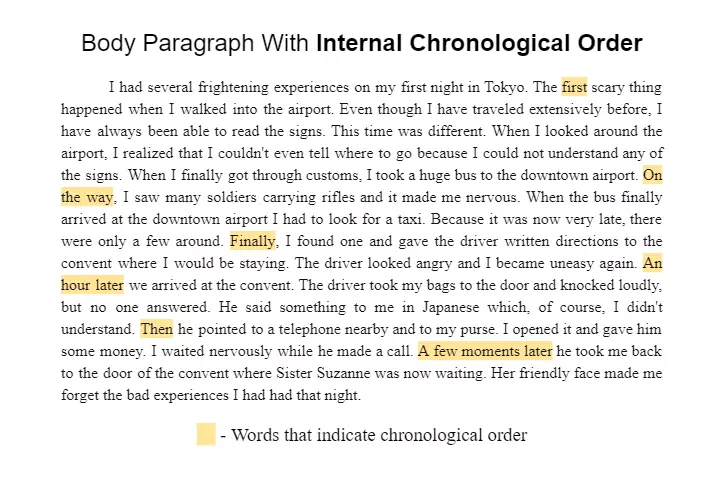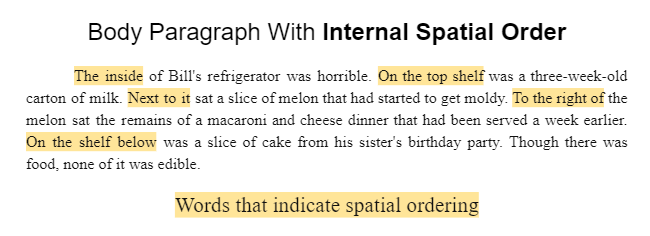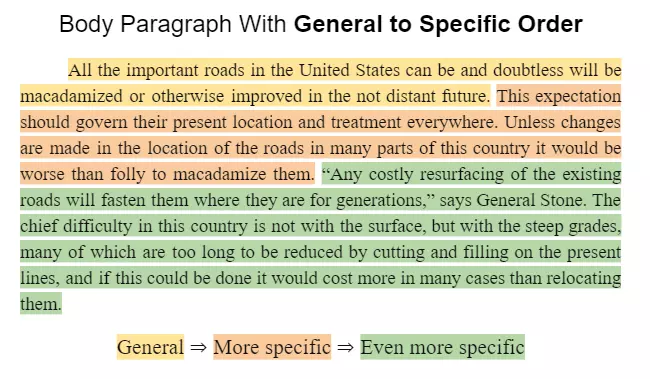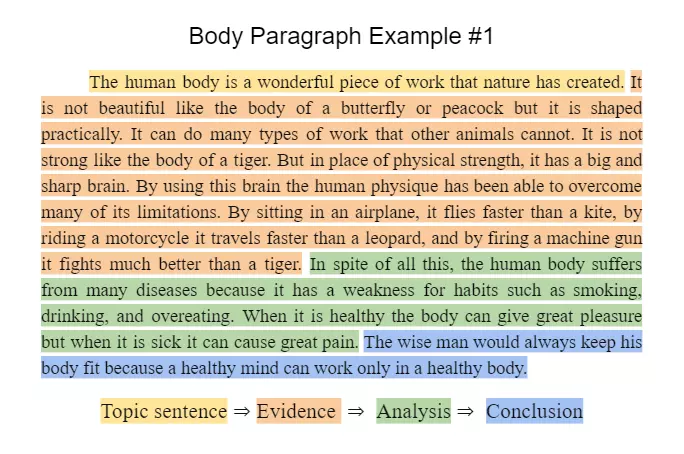Body paragraphs are the parts where you present your evidence and make arguments, which one may argue makes them the most important part of any essay. In this guide, you will learn how to write clear, effective, and convincing body paragraphs in an academic essay.
To learn more about general ways of organizing an essay, you can read our full guide here: Essay Structure Guide.
3 Major Characteristics of a Good Body Paragraph
There are three main elements of a good body paragraph. In short, unity means that the body paragraphs speak only about one concept. Coherence refers to the logical progression of sentences and ideas. And finally, a paragraph that has a good flow uses transition phrases so that each sentence leads on to the next logically. Now, let’s take a closer look at each of these.
1. Unity
Each main paragraph should focus only on one main point, subtopic, or piece of evidence and relay information only about that concept. If a body paragraph contains many different ideas, it can be complicated to understand and less convincing. On the other hand, a paragraph with unity fully explains a concept and ties it to the thesis statement without adding extra information that feels misplaced and may dilute the message.
- The topic sentence of a body paragraph should clearly state the main idea being explored in that paragraph. Each such sentence should have its own paragraph.
- Discuss the connection between the topic sentence and the paper’s thesis.
- All the supporting evidence in the paragraph should connect to the topic sentence.
- Move important information not connected to the topic sentence to another paragraph or revise the topic sentence of that body paragraph.
2. Coherence
Coherence means that there is a logical progression to the sentences and ideas in the paragraph. In other words, paragraphs should be structured in such a way so that they have maximum impact on the audience and make sense. There are several ways to increase coherence within a body paragraph (these are explained later on in this guide):
- Chronological order
- Spatial order
- Emphatic order
3. Flow
Flow refers to the overall readability of a paragraph. Sentences that flow into each other naturally engage the reader and make them more likely to absorb information. One of the simplest ways of improving the flow in a paragraph is by using transitional words and phrases like “specifically,” “on the other hand,” “which leads to the conclusion,” “therefore,” etc. These transition words connect one sentence to another and help the audience keep track of what is happening. Other ways to improve your paragraph flow are:
- Using similar sentence structure throughout the paragraph
- Using pronouns instead of proper nouns
- Repeating important words
Body Paragraph Structure
There is a standard basic structure of a body paragraph that helps bring together unity, coherence, and flow. This structure works well for the standard five-paragraph format of academic writing, but more creative pieces of writing (like a narrative essay) may deviate from this structure and have more than the standard three body paragraphs.
Topic Sentence
The first sentence of a body paragraph should be the topic sentence. Topic sentences clearly state the central idea of the paragraph. You can think of it as one of the main pieces of information or arguments you want to present to back your thesis.
Supporting Evidence
The next few sentences are where you present evidence and research that back up the topic sentence. These supporting sentences logically present research in such a way that strengthens the main claim of the paragraph. Make sure you know the correct citation style for facts and figures and that you cite every piece of information. A well-written body paragraph can still get a bad grade because of low-quality sources or improper citation.
Want to learn more about citing sources? Check related questions here: Citation Guide.
Analysis (Commentary)
After presenting the supporting sentences, you should analyze how the evidence connects to the topic sentence and what it means for the paper overall. Do not assume that the reader will automatically make connections, it is important to make it clear in this writer’s analysis section so that the overall links and ideas are fully explained.
Commentary in an Essay – learn more about analysis in essays and see some examples of commentaries.
Concluding Sentence
The conclusion is usually one or two sentences that clearly show how the supporting facts connect to the topic sentence and why it is important. A concluding sentence is the main takeaway and should present deeper insight into the supporting details and claims made in the paragraph.
Transition Link
The final sentence of a body paragraph plays an important role in enhancing the overall flow of the essay. While it’s not always necessary, it subtly suggests what the next paragraph will cover and smoothly transitions into its opening sentence.
Alternative Body Paragraph Structures
There are two other ways of structuring a body paragraph that you should be aware of. They are very similar to the format above, but you may find them useful for writing different kinds of essays.
P.I.E Format
P.I.E stands for points, information, and explanation. The first thing you should talk about in any paragraph is the answer to, “What is the main point of this paragraph?” This is essentially the same as a topic sentence, which explains what the paragraph will be about or what argument you are going to put forth.
“I” stands for information, which means that you present factual information as supporting sentences that back up your claim. And “E” stands for explanation, which is where you explain why the information you presented is important and how it connects to the overall purpose of the essay.
T.T.E.B Format
T.T.E.B stands for Transition, Topic sentences, Evidence and analysis, and a Brief wrap-up sentence. In this structure, the first thing you do is write a short transition sentence leading on from the previous paragraph to improve flow. After that, it is pretty much the same as we described before. Follow this up with a topic sentence, then present your supporting details and some analysis, and finally end with concluding sentences.
Body Paragraph Examples
Each body paragraph example below is color-coded to show every element it contains.
Body Paragraph Order
In this case, paragraph order can refer to two different things: either the position of the paragraph itself or how the information within a paragraph is ordered. This is closely tied to the concept of coherence and is important to improve the logical build-up of an essay.
Emphatic (Rank)
Emphatic order means presenting evidence in order of importance. This works both for paragraph positions as well as information within a paragraph. The first challenge is ranking your information in terms of strength. This can be determined by the quality of evidence and sources or the logical connection to the thesis statement. The most common way of using this structure is presenting weaker evidence first and building up to the strongest evidence. This leaves the reader with the strongest convincing argument, but in some cases, starting with the strongest evidence and moving to the weakest evidence is useful, for example, when writing for a skeptical audience.

Chronological (Time)
Chronological order is an easy and effective way to organize a paragraph, as it lays out information according to the sequence of events. This approach is commonly used in narrative and process essays, but it can also help structure information within individual paragraphs.

Spatial (Place)
Organizing the information in a paragraph spatially makes the most sense when describing something. This type of ordering uses cues like top to bottom, far to near, and outside to inside to describe things logically in terms of their spatial relations.

Deduction (General to Specific)
This method of organizing a paragraph starts with general information and works its way to specific information. You can start with a general claim and then pick on specific parts of it to bring attention to a unique aspect of it. This is useful in showing cause and effect and drawing conclusions from overarching concepts.

Induction (Specific to General)
This paragraph organization technique begins with specific details and gradually moves to broader ideas. This approach helps illustrate how particular elements relate to larger concepts and highlights the similarities and differences between those concepts.
Induction vs. Deduction – Comparison between the two methods with examples.
How to Write a Body Paragraph (6 Steps)
Now that you’re familiar with the key components of a body paragraph and the different ways to organize them, let’s explore the steps you’ll need to follow to write one effectively.
1. Decide on your order
The first thing you should do is arrange your outline in an order that makes sense for each body paragraph, as well as the order of information within the paragraphs. Keep in mind that just because you have structured your paragraphs in a certain way does not mean that individual paragraphs must follow the same format. Use whichever ordering method makes the most sense to present the information within each separate body paragraph.
2. Write a topic sentence
A topic sentence guides the content of your paragraph, so it’s best to start with it. Consider the main point you want to convey and sum it up in one clear sentence. Think of it like chatting with a friend and sharing three key points that support your main idea. What would those three points be? This simple exercise can help you identify the most important arguments to include.
Often, a thesis statement would contain three main ideas, and each could be extended into a topic sentence.
3. Provide evidence
Logically present your research and evidence in supporting sentences, ensuring unity, coherence, and flow. Think about how this evidence will leave the biggest impact and make sure to cite every source correctly.
4. Analyze the evidence
Explain how the evidence connects to the topic sentence and why the evidence is important. Draw conclusions to strengthen the main claim made in the paragraph.
5. Conclude and transition
Write a conclusion sentence that wraps up the paragraph and reiterates the main idea. A conclusion can be a good transition, or you can add a transition sentence that briefly explains the purpose of the next paragraph.
6. Revise the paragraph
Once you finish writing each paragraph, take a moment to review it for unity, coherence, and smooth flow. Feel free to rearrange details or eliminate any parts that don’t fit. Remember, you’ll have another opportunity to revise the entire paper after your first draft, so focus on addressing the bigger issues for now.
References
- Rochester Institute of Technology – Paragraph Body
- American University – Paragraph Unity and Coherence
- Purdue University – Body Paragraphs









